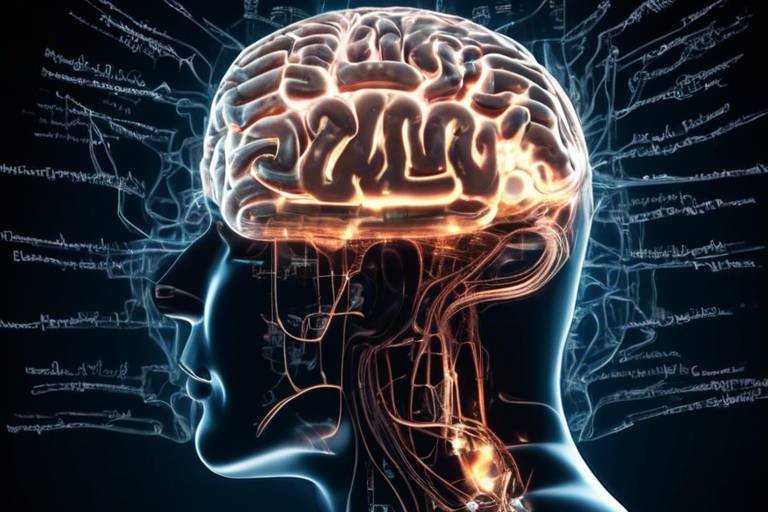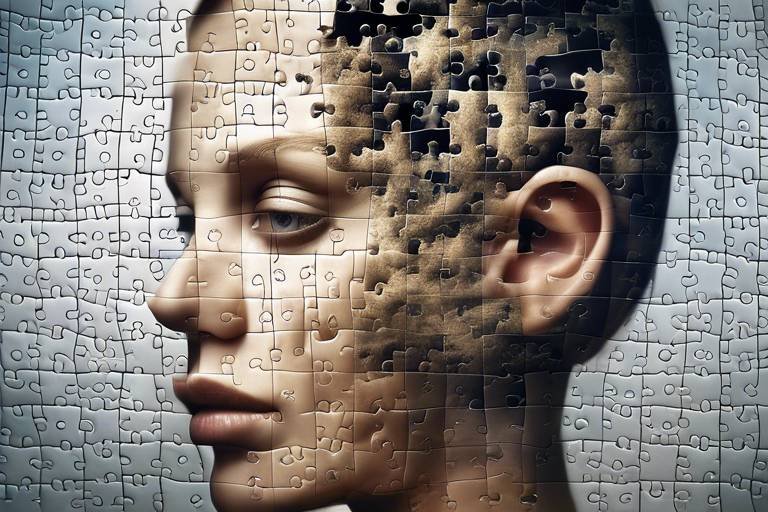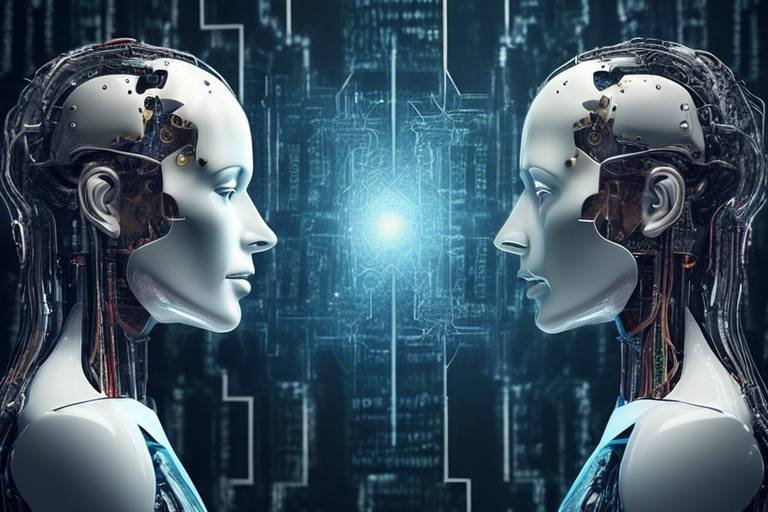The Role of Mind in Human Nature and Culture
The intricate relationship between the human mind and its influence on both nature and culture is nothing short of fascinating. Our minds are not just passive observers; they actively shape our understanding of the world around us. Imagine your mind as a canvas, where every thought, experience, and cultural influence paints a unique picture of reality. This article explores how our cognitive processes intertwine with cultural expressions, ultimately defining our humanity.
At the heart of this exploration lies the concept of cognitive processes. These are the mental activities that enable us to acquire knowledge and understanding through thought, experience, and our senses. From the moment we wake up to the time we go to bed, our minds are continuously at work, processing information, making decisions, and influencing our behaviors. Have you ever wondered why we react differently to similar situations? It’s because our minds are shaped by our experiences, cultural backgrounds, and societal norms.
Consider this: when faced with a challenge, one person may approach it with determination and optimism, while another might feel overwhelmed and anxious. This difference in response can often be traced back to cognitive processes influenced by culture. For instance, cultures that promote individualism may encourage people to tackle challenges head-on, while collectivist cultures might emphasize seeking support from others. This interplay between mind and culture not only shapes our behavior but also influences our emotional responses and social interactions.
As we delve deeper, we find that culture significantly shapes our thought processes. Cultural norms and values act as a lens through which we interpret the world. They guide our decision-making, define our moral compass, and influence our perceptions of right and wrong. For example, in some cultures, community welfare is prioritized over individual success, leading to a different set of values and thought patterns. This cultural influence is akin to a guiding star, steering our thoughts and actions in specific directions.
Furthermore, the role of language in shaping thought cannot be overstated. Language is not merely a tool for communication; it is a powerful force that molds our cognitive frameworks. The way we express ourselves in different languages can significantly alter our thought processes. For instance, some languages have specific words for emotions or concepts that others do not, which can lead to varying degrees of emotional understanding and expression. This phenomenon illustrates how language diversity contributes to cognitive variability across cultures.
Moreover, the process of language acquisition is deeply rooted in cultural context. Children learn to speak not only through imitation but also by absorbing the cultural nuances embedded in their environment. This acquisition process affects their cognitive development and shapes their social interactions. Just think about how a child growing up in a bilingual household might develop a different perspective on identity compared to a child raised in a monolingual environment. The interplay of language and culture enriches the tapestry of human thought, showcasing the diversity of our cognitive experiences.
As we navigate through the complexities of human nature, we must also acknowledge the role of emotional intelligence across cultures. Emotional intelligence—the ability to understand and manage our emotions and the emotions of others—varies significantly from one culture to another. In some societies, emotional expression is encouraged, fostering strong interpersonal relationships and social cohesion. In contrast, other cultures may promote emotional restraint, leading to different approaches to conflict resolution and social interaction.
In conclusion, the mind is a powerful entity that shapes our understanding of nature and culture. It is a dynamic interplay of cognitive processes influenced by cultural norms, language, and emotional intelligence. By appreciating this complexity, we can better understand the rich tapestry of human experience that defines our existence. As we continue to explore the depths of human nature, we uncover the profound ways in which our minds shape not only our individual lives but also the cultures we inhabit.
- What is the relationship between mind and culture? The mind influences how we perceive and interact with the world, while culture shapes our cognitive processes and emotional responses.
- How does language impact thought? Language shapes our thought patterns and emotional expressions, influencing how we understand and interpret our experiences.
- What is emotional intelligence, and why is it important? Emotional intelligence is the ability to understand and manage emotions, which is crucial for building strong relationships and social cohesion.

Cognitive Processes and Human Behavior
Understanding cognitive processes is crucial for deciphering human behavior. Our minds are like intricate machines, constantly processing information, making decisions, and influencing our interactions with others. Think about it: every action we take, from the simplest of choices to complex social interactions, is driven by a series of thoughts, perceptions, and emotions. These cognitive processes are the unseen gears that keep our social machinery running smoothly.
At the core of human behavior lies the interplay between our thoughts and feelings. For instance, when faced with a challenge, our cognitive processes kick in, allowing us to evaluate the situation, weigh our options, and ultimately decide on a course of action. This is where emotions come into play. They can either propel us forward or hold us back. Imagine trying to make a decision while feeling anxious; that anxiety can cloud your judgment, leading to choices that might not align with your true desires or values.
Moreover, our perceptions of the world around us significantly shape our behavior. We interpret events through our unique lens of experiences, cultural background, and personal beliefs. This subjectivity can lead to vastly different reactions to the same situation. For example, two people might witness the same event but interpret it through different emotional and cognitive filters, leading to divergent responses. This phenomenon illustrates the complexity of human behavior and the vital role cognitive processes play in shaping our actions.
To further understand these processes, let’s break them down into key components:
- Attention: The ability to focus on specific stimuli while ignoring others. This is crucial in determining what information we process and how we react to it.
- Memory: Our past experiences inform our current decisions. The way we recall events can significantly influence our behavior in similar future situations.
- Problem-Solving: This involves using cognitive skills to navigate challenges. Our approach to problem-solving is often influenced by our emotional state and cognitive biases.
- Decision-Making: This is the culmination of all cognitive processes, where we evaluate options and make choices based on our thoughts and feelings.
In conclusion, cognitive processes are at the heart of human behavior. They shape our interactions, influence our decisions, and ultimately define who we are as individuals and as members of society. By understanding these processes, we can gain valuable insights into the complexities of human nature, paving the way for better communication and deeper connections with others.
- What are cognitive processes? Cognitive processes refer to the mental activities involved in acquiring knowledge and understanding, including thinking, memory, perception, and problem-solving.
- How do emotions influence behavior? Emotions can significantly impact our decisions and actions, often guiding us in ways that align with our feelings rather than rational thought.
- Can cognitive processes be improved? Yes, through practices such as mindfulness, cognitive-behavioral techniques, and continuous learning, we can enhance our cognitive abilities.

The Influence of Culture on Thought
Culture is like the lens through which we view the world; it shapes our thoughts, perceptions, and actions in profound ways. When we talk about cognitive frameworks, we are essentially discussing how our cultural background influences the way we think. For instance, individuals raised in collectivist societies, where community and family are prioritized, often exhibit different thought patterns compared to those from individualistic cultures, where personal achievement and independence are emphasized. This difference can be seen in various aspects of life, from decision-making processes to conflict resolution styles.
One of the most intriguing aspects of this cultural influence is how it manifests in our decision-making. In cultures that value hierarchy and respect for authority, decisions may be made more conservatively, with a focus on maintaining social harmony. Conversely, in cultures that celebrate innovation and risk-taking, individuals might be more inclined to challenge norms and pursue unconventional paths. This cultural backdrop not only guides how we think but also how we relate to one another, shaping our interactions and relationships within society.
Furthermore, cultural norms dictate what is considered acceptable or taboo, which in turn influences our thought processes. For example, in some cultures, discussing emotions openly is encouraged, fostering an environment where emotional intelligence can thrive. In contrast, other cultures may view emotional expression as a sign of weakness, leading individuals to suppress their feelings, which can hinder their cognitive and emotional development. This brings us to the fascinating interplay between cultural values and cognitive development, where the former acts as a guiding force for the latter.
To illustrate this influence, consider the following table that highlights key cultural dimensions and their impact on cognition:
| Cultural Dimension | Influence on Thought |
|---|---|
| Individualism vs. Collectivism | Shapes personal vs. group-oriented decision-making. |
| Power Distance | Affects attitudes towards authority and hierarchy. |
| Uncertainty Avoidance | Influences risk-taking and innovation. |
| Masculinity vs. Femininity | Guides competitive vs. cooperative behaviors. |
This table demonstrates that culture is not just a backdrop but an active player in shaping our thought processes. It’s fascinating how cultural contexts can lead to variations in cognitive styles and approaches to problem-solving. For instance, in cultures that prioritize harmony, individuals might adopt a more holistic approach to understanding issues, while those from more analytical cultures may focus on dissecting problems into smaller parts.
In conclusion, the influence of culture on thought is a complex and dynamic interplay that shapes our cognitive frameworks and decision-making processes. By understanding this relationship, we can gain deeper insights into human behavior and the diverse ways individuals navigate their worlds. As we explore further into the realms of language, emotion, and morality, it becomes evident that culture is the thread that weaves together the fabric of human thought.
- How does culture influence our decision-making?
Cultural values and norms shape how we approach decisions, whether we prioritize individual goals or collective well-being.
- Can cultural differences affect emotional intelligence?
Yes, different cultures have varying norms regarding emotional expression, which can impact the development of emotional intelligence.
- What role does language play in shaping thought?
Language influences cognitive patterns, affecting how we categorize experiences and express ideas.

Language and Thought
Language is not just a tool for communication; it is the very lens through which we perceive the world. Imagine walking through a vibrant forest, filled with the rustle of leaves and the chirping of birds. If you have the words to describe this experience, you can share it with others, but if you lack the vocabulary, the beauty of the moment may remain locked within you. This illustrates the profound connection between language and thought. The way we articulate our thoughts can shape our understanding of reality, influencing not only individual cognition but also collective cultural identity.
Research suggests that the structure of a language can affect how its speakers think. For example, speakers of languages that have specific words for colors may perceive those colors differently than speakers of languages without such distinctions. This phenomenon is often referred to as the Whorfian hypothesis, which posits that the language we speak can influence our cognitive processes. In essence, language does not merely reflect our thoughts; it can actively shape them. This leads to the intriguing question: do we think differently because we speak different languages?
Moreover, language is deeply intertwined with cultural identity. It acts as a vessel for cultural values and societal norms, encapsulating the essence of a community's experiences and beliefs. For instance, in many indigenous cultures, the language includes concepts that reflect a deep connection to nature, which may not exist in more industrialized societies. This difference in linguistic structure can lead to different ways of thinking about the environment, community, and even time.
The acquisition of language is also a crucial aspect of cognitive development. Children learn to express their thoughts and emotions through language, which in turn shapes their understanding of the world. The process is influenced by the cultural context in which they are raised. For example, children in collectivist cultures may learn to use language in ways that emphasize community and relationships, while those in individualistic cultures may focus more on self-expression and personal achievement. This divergence in language use highlights how cultural context can mold cognitive development.
To delve deeper into the relationship between language and thought, it is essential to consider how different languages can lead to cognitive variability. For instance, some languages have grammatical structures that require speakers to indicate the source of their information, which can influence how they perceive credibility and trustworthiness. This can lead to variations in judgment and decision-making processes across cultures.
In conclusion, the interplay between language and thought is a dynamic and complex relationship that shapes not only individual cognition but also cultural expressions. By understanding this connection, we can gain insights into how different societies interpret their realities and foster a greater appreciation for the rich tapestry of human experience.
- How does language influence thought?
Language influences thought by providing the structure and vocabulary needed to articulate ideas, which can shape how we perceive and understand our experiences. - Can people think without language?
While language is a powerful tool for thought, it is possible to have thoughts that are not verbalized. Many people experience non-verbal thoughts, such as images and feelings. - What is the Whorfian hypothesis?
The Whorfian hypothesis suggests that the language we speak can influence our cognitive processes and shape how we perceive the world around us.

Language Diversity and Cognitive Variability
Language is not just a tool for communication; it is a powerful lens through which we perceive the world. The diversity of languages across the globe reflects a vast array of cognitive styles, influencing how individuals think, reason, and express themselves. For instance, speakers of languages that emphasize certain grammatical structures may find themselves interpreting situations and emotions differently than those who speak languages with different structures. This phenomenon raises an intriguing question: does the language we speak shape the very way we think?
Research has shown that language can affect cognitive processes such as memory, perception, and categorization. For example, in some cultures, the way colors are categorized can vary significantly. In languages that have multiple terms for what English speakers would simply call "blue," speakers are often better at distinguishing between shades of blue. This suggests that language diversity corresponds with cognitive variability, leading us to wonder how much of our understanding of the world is rooted in the words we use.
Furthermore, the relationship between language and thought is not merely one-sided. While language can shape thought, our cognitive experiences can also influence language development. Children learn language in context, absorbing the nuances of their environment. This leads to the idea that language acquisition is deeply intertwined with cultural context. For instance, a child growing up in a bilingual household may develop unique cognitive skills that allow them to navigate multiple cultural frameworks simultaneously.
To illustrate this point, consider the following table that compares cognitive characteristics associated with different language families:
| Language Family | Cognitive Characteristics |
|---|---|
| Indo-European | Linear thinking, focus on object permanence |
| Sino-Tibetan | Contextual thinking, emphasis on relational dynamics |
| Austronesian | Fluidity in categorization, adaptability in communication |
This table highlights how different linguistic structures may lead to distinct cognitive patterns. For instance, speakers of Indo-European languages might approach problem-solving in a more linear fashion, while those from Sino-Tibetan backgrounds may prioritize context and relationships in their reasoning processes. Such differences are not merely academic; they have real-world implications for how people interact, negotiate, and understand each other in multicultural settings.
In conclusion, the interplay between language diversity and cognitive variability is a fascinating area of study that sheds light on the rich tapestry of human thought. As we continue to explore this relationship, it becomes increasingly clear that our linguistic choices do not just reflect our thoughts—they actively shape them. Understanding this dynamic can enhance our appreciation of cultural differences and improve communication across diverse societies.
- How does language influence thought? Language shapes our cognitive processes by providing frameworks for categorizing experiences and emotions.
- Can learning a new language change the way I think? Yes, learning a new language can introduce new ways of thinking and perceiving the world, as different languages emphasize different concepts.
- What role does culture play in language acquisition? Cultural context is crucial in language acquisition, as it influences the vocabulary, expressions, and social norms that shape communication.
- Are there cognitive advantages to being bilingual? Bilingual individuals often exhibit greater cognitive flexibility and enhanced problem-solving skills due to their ability to navigate multiple linguistic frameworks.

Language Acquisition and Cultural Context
Language acquisition is not just a mechanical process of learning words and grammar; it is a complex interplay between the mind and the cultural environment in which an individual is immersed. From the moment a child is born, they are surrounded by sounds, gestures, and expressions that are steeped in cultural significance. This environment plays a crucial role in shaping not only how they learn to communicate but also how they perceive the world around them. Have you ever noticed how a child’s first words often reflect their immediate reality? For instance, a child in a rural setting might first learn the names of animals or plants, while a city child might focus on vehicles or electronic devices. This early exposure highlights the profound impact of cultural context on language acquisition.
Moreover, the process of acquiring language is deeply intertwined with social interactions. Children learn to speak by mimicking the sounds and phrases they hear from parents, caregivers, and peers. This mimicking is not merely about pronunciation; it is also about understanding the social cues and emotional contexts that accompany language use. For example, the way a parent expresses joy or disappointment can teach a child not only vocabulary but also the emotional weight that certain words carry. In various cultures, the emphasis on communal or individualistic values can shape how language is used and learned. In collectivist cultures, language may be used to reinforce group identity and harmony, while in individualistic societies, communication might focus more on self-expression.
The cultural context also dictates the methods of language instruction and the importance placed on different aspects of language. In some cultures, storytelling is a vital part of language learning, where narratives passed down through generations teach not only language but also cultural values and norms. In others, formal education might dominate, emphasizing grammar and vocabulary over conversational skills. This leads to varied outcomes in language proficiency and cognitive development. For instance, children raised in environments that prioritize storytelling may develop a richer vocabulary and a more nuanced understanding of narrative structures compared to those who learn language primarily through rote memorization.
To illustrate the relationship between language acquisition and cultural context, consider the following table that summarizes key aspects:
| Cultural Context | Language Acquisition Method | Outcome |
|---|---|---|
| Collectivist Cultures | Storytelling and communal activities | Rich vocabulary and emotional intelligence |
| Individualistic Cultures | Formal education and self-directed learning | Focus on self-expression and analytical skills |
| Multilingual Environments | Simultaneous exposure to multiple languages | Cognitive flexibility and enhanced problem-solving abilities |
In conclusion, the journey of language acquisition is a fascinating reflection of cultural identity and social interaction. It is a vivid reminder that learning to communicate transcends mere vocabulary; it is a fundamental aspect of human nature that shapes how we think, feel, and connect with others. Understanding this relationship can lead to deeper insights not only into language learning but also into the broader implications for cognitive development and social cohesion.
- How does cultural context impact language acquisition? Cultural context influences the vocabulary, expressions, and communication styles that children learn, shaping their understanding of the world.
- What role do parents play in language acquisition? Parents are crucial in providing the linguistic input and emotional context that children need to learn language effectively.
- Can bilingualism affect cognitive development? Yes, bilingualism can enhance cognitive flexibility and problem-solving skills, offering unique advantages in language processing.

Emotional Intelligence Across Cultures
Emotional intelligence (EI) is a fascinating concept that transcends borders, shaping how individuals navigate their social worlds. It's like the oil that keeps the machinery of human interaction running smoothly, allowing us to connect, empathize, and communicate effectively. But here's the kicker: emotional intelligence isn't a one-size-fits-all trait. It varies significantly across different cultures, influenced by societal norms, values, and expectations.
For instance, in Western cultures, emotional expression is often encouraged and viewed as a sign of authenticity. People are taught to articulate their feelings openly, which fosters a culture of transparency and direct communication. On the other hand, in many Eastern cultures, emotional restraint is valued. Here, showing too much emotion might be perceived as a loss of face or a disruption of social harmony. This divergence raises an intriguing question: how do these cultural differences affect interpersonal relationships and social cohesion?
To illustrate this point, let's examine a few key aspects of emotional intelligence across cultures:
- Expression of Emotions: In cultures that prioritize individualism, such as the United States, people might be more inclined to express their emotions freely. Conversely, collectivist cultures, such as Japan, may emphasize emotional control and subtlety.
- Empathy: While empathy is a universal trait, its expression can differ. In some cultures, empathy is shown through actions rather than words, highlighting the importance of nonverbal communication.
- Conflict Resolution: Cultures with high emotional intelligence often prioritize harmony and consensus. This can lead to different approaches in resolving conflicts, where some may prefer direct confrontation while others opt for indirect methods.
These differences in emotional intelligence can lead to misunderstandings in cross-cultural interactions. For example, a person from a culture that values emotional expression may misinterpret the reserved demeanor of someone from a culture that emphasizes restraint as indifference. This highlights the importance of cultural competence—the ability to understand and respect cultural differences in emotional expression.
Moreover, emotional intelligence is not static; it can evolve with cultural exchanges and globalization. As people from diverse backgrounds interact more frequently, there is potential for a blending of emotional expressions and understandings. This cross-pollination can lead to a richer, more nuanced approach to emotional intelligence that embraces both individual expression and collective harmony.
In conclusion, emotional intelligence is a dynamic and culturally embedded phenomenon. Recognizing and appreciating these differences can enhance our ability to connect with others, fostering deeper relationships and promoting social cohesion across cultures. So, the next time you find yourself in a cross-cultural setting, remember that emotional intelligence might just be the key to unlocking meaningful connections.

Mind and Moral Development
When we think about morality, it’s easy to imagine a set of rules or guidelines that dictate what is right and wrong. However, the journey to understanding morality is far more complex and deeply rooted in our cognitive processes. The way our minds develop moral reasoning is influenced by a myriad of factors, including our upbringing, cultural context, and personal experiences. It’s like building a house; the foundation is laid through early experiences, and as we grow, we add rooms and decorations that reflect our values and beliefs.
At the core of moral development is the interplay between cognitive abilities and emotional understanding. Cognitive development provides the structure for moral reasoning, while emotional intelligence enriches it with empathy and compassion. Think of it as a dance where both partners must be in sync to create a harmonious performance. For instance, children learn to distinguish right from wrong not just through rules but also by observing the reactions of those around them. Their ability to empathize with others plays a crucial role in shaping their moral compass.
One of the most influential theories of moral development comes from psychologist Lawrence Kohlberg, who proposed a stage theory that outlines how individuals progress through different levels of moral reasoning. According to Kohlberg, these stages reflect a person's ability to think about ethical dilemmas and understand the perspectives of others. Here’s a brief overview of his stages:
| Stage | Description |
|---|---|
| 1 | Obedience and Punishment Orientation |
| 2 | Self-Interest Orientation |
| 3 | Interpersonal Accord and Conformity |
| 4 | Authority and Social Order Maintaining Orientation |
| 5 | Social Contract Orientation |
| 6 | Universal Ethical Principles |
As individuals progress through these stages, their understanding of morality becomes more nuanced. They begin to grasp that moral decisions can be complex and that different perspectives can lead to different conclusions. This evolution in thinking is not just an intellectual exercise; it’s a vital aspect of human nature that fosters social cohesion and cooperation within communities.
However, moral development is not a linear path. Cultural influences play a significant role in shaping how we perceive morality. For example, in collectivist cultures, the emphasis may be placed on community and familial obligations, while individualistic cultures might prioritize personal rights and freedoms. This divergence highlights the importance of context in understanding moral behavior. It’s like viewing a painting from different angles; each perspective reveals new details and interpretations.
Moreover, moral development is an ongoing process. Even as adults, our moral reasoning can evolve through new experiences and reflections. Engaging in discussions about ethical dilemmas, reflecting on personal values, and considering the implications of our actions can all contribute to our moral growth. This continuous journey is what makes us human; it allows us to adapt, learn, and strive for a more just society.
In conclusion, the relationship between the mind and moral development is intricate and multifaceted. It involves a blend of cognitive reasoning, emotional intelligence, and cultural context. Understanding this relationship not only enriches our comprehension of human nature but also highlights the significance of fostering environments that encourage moral growth and ethical behavior.
- What is moral development? Moral development refers to the process through which individuals learn to distinguish right from wrong and develop their ethical beliefs.
- Who proposed the stages of moral development? Lawrence Kohlberg proposed the stages of moral development, outlining how individuals progress through different levels of moral reasoning.
- How does culture influence morality? Culture shapes our understanding of morality by emphasizing different values, such as community obligations in collectivist cultures versus individual rights in individualistic cultures.
- Can moral development change over time? Yes, moral development is an ongoing process, and individuals can evolve their moral reasoning through new experiences and reflections.

Philosophical Perspectives on Morality
When we dive into the world of morality, we quickly realize that it’s not just a black-and-white issue; it’s a vibrant tapestry woven from various philosophical threads. Different schools of thought offer unique insights into what constitutes right and wrong, shaping our ethical frameworks and influencing how we interact with one another. For instance, consider utilitarianism, a philosophy that suggests the best action is the one that maximizes overall happiness. This perspective encourages us to weigh the consequences of our actions, asking ourselves, "Will this lead to the greatest good for the greatest number?" It’s a practical approach, but it also raises questions about individual rights and whether the end justifies the means.
On the other hand, we have deontological ethics, which emphasizes duties and rules. Think of it as a strict rulebook for morality. According to this view, certain actions are inherently right or wrong, regardless of their outcomes. This perspective can be comforting, as it provides clear guidelines. However, it can also create dilemmas; for example, if lying could save a life, should one still adhere to the rule of honesty? These philosophical debates are not just academic; they resonate deeply in our daily lives, influencing everything from personal decisions to public policy.
Moreover, virtue ethics takes a different angle by focusing on the character of the moral agent rather than specific actions. This perspective invites us to reflect on who we want to be as individuals. Are we striving to cultivate virtues like courage, honesty, and compassion? This approach fosters a sense of personal responsibility and encourages us to develop our moral compass. It’s less about following rules and more about nurturing a virtuous character that guides our actions.
In addition to these frameworks, we must consider how morality is influenced by cultural contexts. Different societies often have varying moral standards, shaped by their unique histories, traditions, and social norms. For instance, what might be considered acceptable in one culture could be taboo in another. This cultural relativism challenges the notion of universal morality and invites us to engage in a broader dialogue about ethical principles. It raises intriguing questions: Are there moral truths that transcend cultures, or is morality entirely subjective?
As we explore these philosophical perspectives, it becomes evident that morality is a complex interplay of thought, culture, and human experience. Each perspective offers valuable insights, but no single philosophy can fully encapsulate the richness of human morality. Instead, they serve as lenses through which we can examine our beliefs and actions, encouraging us to think critically about what it means to live a good life. In this light, the study of morality is not just an academic endeavor; it's a deeply personal journey that challenges us to reflect on our values and the impact we have on the world around us.
- What is the main focus of philosophical perspectives on morality?
Philosophical perspectives on morality primarily focus on understanding the principles and reasoning behind moral judgments, exploring various frameworks like utilitarianism, deontology, and virtue ethics. - How do cultural contexts influence moral beliefs?
Cultural contexts shape moral beliefs by providing unique histories, traditions, and social norms, leading to diverse interpretations of what is considered right or wrong. - Can morality be universal?
The question of whether morality can be universal is debated among philosophers, with some arguing for universal moral truths while others advocate for cultural relativism.

Psychological Theories of Morality
The realm of morality has fascinated thinkers for centuries, and psychological theories offer a fascinating lens through which we can explore the intricate web of human ethics and behavior. At its core, morality encompasses the principles that govern our sense of right and wrong, guiding our actions and decisions in a complex social world. Psychological theories of morality delve into the cognitive processes that underlie moral reasoning, revealing how our minds navigate ethical dilemmas and moral judgments.
One prominent theory is the Social Intuitionist Model, proposed by psychologist Jonathan Haidt. This model posits that moral judgments are primarily driven by intuitive responses rather than deliberate reasoning. Imagine walking through a crowded street and witnessing an act of kindness or cruelty. Your gut reaction—whether it's admiration or disgust—can often precede any rational thought. This theory suggests that our emotional responses are powerful motivators in moral decision-making, often overshadowing logical reasoning.
Another significant perspective is the Cognitive Development Theory by Jean Piaget and later expanded by Lawrence Kohlberg. This theory emphasizes the role of cognitive development in shaping moral reasoning. According to Kohlberg, moral reasoning progresses through distinct stages, starting from a simplistic understanding of right and wrong based on punishment and reward, to a more complex grasp of universal ethical principles. This journey can be likened to climbing a mountain, where each stage represents a higher viewpoint, allowing individuals to see the broader implications of their actions.
Moreover, the Evolutionary Psychology approach offers insights into how morality may have evolved as a social mechanism for promoting cooperation and group cohesion. From this perspective, moral behaviors can be viewed as adaptations that enhance survival. For instance, altruism—acting in the interest of others—can be seen as a strategy that fosters group loyalty and increases the chances of survival for the community. This theory implies that our moral instincts are not merely cultural constructs but have deep-rooted biological foundations.
To illustrate the various psychological theories of morality, the following table summarizes key theories and their main ideas:
| Theory | Key Concepts |
|---|---|
| Social Intuitionist Model | Moral judgments are primarily intuitive; emotions drive moral reasoning. |
| Cognitive Development Theory | Moral reasoning progresses through stages, influenced by cognitive development. |
| Evolutionary Psychology | Morality evolved as a social mechanism to enhance cooperation and survival. |
Additionally, the Dual Process Theory posits that moral reasoning involves two systems: the intuitive, emotional system and the rational, deliberative system. This duality suggests that while we may feel an immediate emotional response to a moral situation, our rational mind can later analyze and justify our feelings. This interplay between intuition and reasoning is crucial in understanding the complexity of moral judgments and highlights the dynamic nature of human thought.
In conclusion, psychological theories of morality provide a rich tapestry of insights into how we navigate ethical landscapes. They reveal that morality is not a one-size-fits-all concept but rather a multifaceted phenomenon influenced by cognitive development, emotional responses, and evolutionary factors. As we continue to explore these theories, we gain a deeper understanding of what it means to be human—how our minds shape our morals, and in turn, how our morals shape our world.
- What is the Social Intuitionist Model? - A theory that suggests moral judgments are primarily driven by intuitive emotional responses rather than deliberate reasoning.
- How does Cognitive Development Theory explain moral reasoning? - It posits that moral reasoning progresses through distinct stages influenced by cognitive development.
- What role does Evolutionary Psychology play in understanding morality? - It suggests that moral behaviors evolved as adaptations to promote cooperation and survival within groups.
- What is Dual Process Theory? - A theory that proposes moral reasoning involves both intuitive emotional responses and rational deliberation.
Frequently Asked Questions
- What is the role of the mind in shaping human behavior?
The mind plays a crucial role in shaping human behavior through cognitive processes such as thinking, perception, and emotion. These elements drive our actions and interactions with others, influencing everything from personal decisions to societal norms.
- How does culture influence thought processes?
Culture significantly impacts how individuals think and make decisions. Norms, values, and traditions within a culture shape cognitive frameworks, guiding how people interpret experiences and respond to various situations.
- What is the connection between language and thought?
Language is not just a means of communication; it actively shapes our thought patterns. The way we express ideas and emotions in different languages can influence our cognitive styles and cultural identity, creating a unique interplay between language and thought.
- How does language diversity affect cognitive variability?
Different languages can lead to diverse cognitive styles. For instance, some languages may emphasize certain concepts more than others, which can affect how speakers of those languages perceive the world and process information.
- What role does emotional intelligence play across cultures?
Emotional intelligence varies widely among cultures, affecting how individuals understand and manage emotions in themselves and others. This variation influences interpersonal relationships and overall social cohesion within different societies.
- How does the mind contribute to moral development?
The mind is integral to moral development, as it processes ethical dilemmas and influences moral reasoning. Cognitive functions help individuals navigate complex moral landscapes, shaping their understanding of right and wrong based on personal and cultural contexts.
- What are some philosophical perspectives on morality?
Various philosophical perspectives offer insights into moral development, examining concepts like utilitarianism, deontology, and virtue ethics. These views shape cultural morals and values, providing frameworks for understanding ethical behavior across different societies.
- What psychological theories explain moral behavior?
Psychological theories, such as Kohlberg's stages of moral development and social learning theory, provide explanations for how moral behavior is formed. These theories help us understand the cognitive processes behind ethical decision-making in various cultural contexts.



















